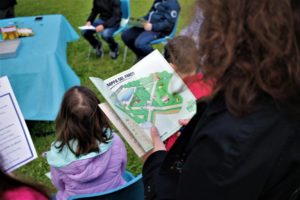 Scientific Adventure Playground is an outreach initiative designed and organized by PONYS – Physics & Optics Naples Young Students, in partnership with the Environmental Department of Naples City Council and the National Institute for Nuclear Physics.
Scientific Adventure Playground is an outreach initiative designed and organized by PONYS – Physics & Optics Naples Young Students, in partnership with the Environmental Department of Naples City Council and the National Institute for Nuclear Physics.
The idea
Playing is a very powerful way of learning, as everyone knows. Over the last years PONYS have designed a large number of demonstrative experiments, exploring different areas of physics, which have been proposed in many outreach events as a collection of separated stands. What if these very same experiments were collected in a consistent way, giving rise to a scientific game where participants can play and learn at the same time? And what if this could be done in a wonderful location, such as an urban park, delivering also an environmental message? And what if this scientific game took place in two of the toughest neighborhoods of Naples? Put all this together, and you’ll catch the idea at the heart of the Scientific Adventure Playground.
Location
The event took place in two urban parks located at the opposite sides of Naples, one week away one another:
“Villa di Scampia”, April 22ndScampia has become worldwide famous in last years because of its involvement in organized crime issues, as witnessed by Roberto Saviano’s bestseller book “Gomorra” and the subsequent screen adaptations. Its characteristic buildings, “le vele” (“the sails”) have become the symbol of the degradation of this area.
“Parco Massimo Troisi”, San Giovanni a Teduccio, April 29thEntitled to the Academy-Award-winning actor and film director Massimo Troisi, who was born in this neighborhood, this park is located just a few steps away from a huge portrait of Diego Armando Maradona, painted in 2016 by the street artist Jorit.
Target and Objectives
The event was addressed mainly to children of 8 – 13 years old, but it turned out that this kind of activity is perfectly suitable with little variations to a much larger audience.The objectives of Scientific Adventure Playground were:
• Stimulate interest in physics and science in general;
• Make children explore the urban park, walking around and discovering its beauty; • Sensitize the public to environmental issues and to the respect of public places.
The Game
The aim of the game is to explore the park using the Scientific Explorer Kit provided at the entrance, attend a number of physics experiments and overcome the challenges, namely answering some simple questions.
There are three routes to follow, of three different colors. Each route develops a topic and is divided into three stages: each stage consists in a stand focusing on a particular area of physics, thematically coherent to the whole route. The routes are:
• Waves Route, Blue – Optics, Electromagnetism, Acustic
• Elements Route, Red – Geophysics, Astrophysics, Fluid Dynamics
• Energy Route, Yellow – Combustion, Soap Bubbles, Smart Materials
Following the routes and answering the questions the visitor can fill his/her Scientific Passport with stamps, which mark his/her proceedings, and win some prizes provided he/she answers correctly to at least one question out of three for any given route.
The framework of the game provides motivation and engagement. Paying attention to the experiments is essential to answer correctly and win the prize, which works just as a catalyzer. In order to stress this point and avoid to overestimate the importance of the prize, the criteria designed to win it have been chosen carefully, focusing on the importance of the experience itself rather than on the stakes.
The Scientific Explorer Kit
At the entrance of the park, the visitor receives the Scientific Explorer Kit, containing all the necessary to play. It contains the following:
Map of the park. Drawn by PONYS, it contains some elements useful to orient yourself in the park (buildings, trees and so on) in addition to other elements which are essential to the game, such as the colored flags, which mark the stages od the routes, and the Checkpoint, where visitors go to check their answers.
Scientific Passport. It marks the proceedings of the visitor. It’s personal, customizable with Name, Surname, Date of Birth, Signature and Photo. Each box to be stamped carries the name of a famous scientist and little logo attached to it: this simple feature, besides offering the opportunity to talk about great scientists of our history, stimulates interest through the idea of “collecting scientists”.
Challenge Sheet (red, blue or yellow). It contains three multiple answer questions, related to the three stages of a given route. After answering the first Challenge Sheet, the visitor can take another sheet at the Checkpoint and continue to play, until he has finished all the routes.
The Physics Garden
This is an open area, separated from the colored routes and the question-answer game, where the link between physics and sport is investigated through interactive experiences. Many activities are covered: football, basketball, dancing, diving and others. This area allows to continue to play even after all the routes have been completed, and is particularly fitting to the park setting.
The INFN Stand
The Naples Section of the National Institute for Nuclear Physics supported the event and participated with a stand illustrating the physics of cosmic rays and how muons coming from outer space are currently used for volcanos and subsoil radiography. This part of the activity was particularly suitable to grown-up kids and adults accompanying their children
